

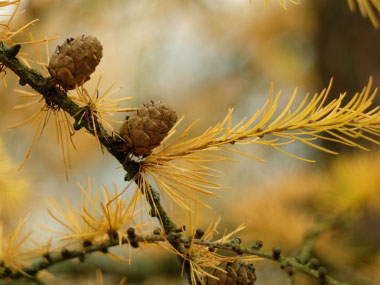
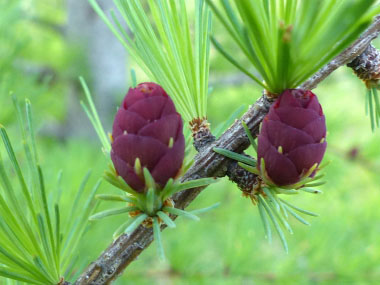
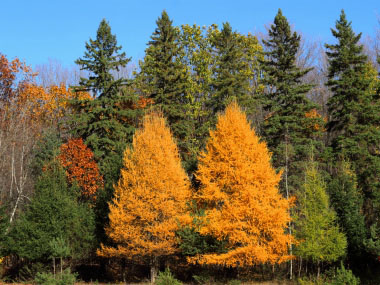

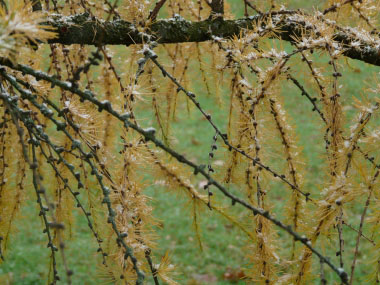
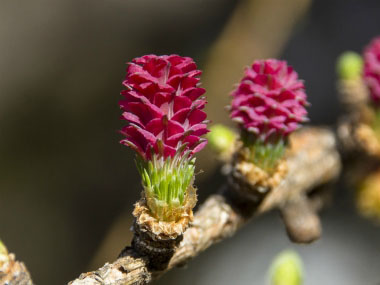
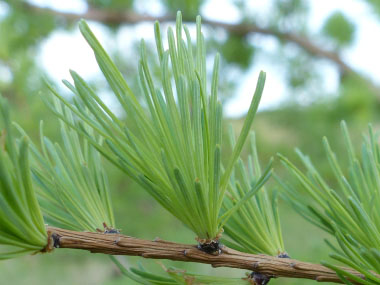

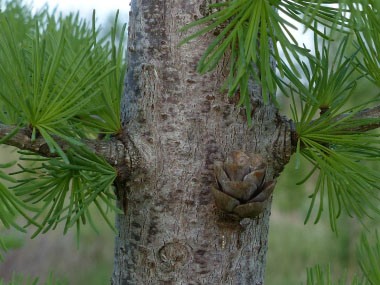
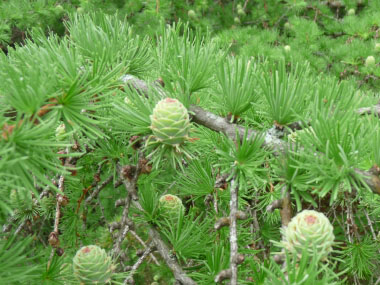
To support our efforts please browse our store (books with medicinal info, etc.).
The tamarack, also known as the American larch, hackmatack, or eastern larch is a deciduous conifer, one of only few species of conifers that are not evergreen. It is in the Pinaceae (pine) family. In the autumn the needles of this small to medium sized tree turn a beautiful golden yellow and fall off. The common name of Larix laricina, tamarack, is likely derived from the Algonquian word that refers to a type of wood for making snowshoes. This tree can survive very cold temperatures of -65 degrees C (-85 degrees F) and can live up to 180 years. The tamarack was commonly used medicinally by many First Nations people.
Trunk/Bark
The bark of a young tamarack is grayish to reddish brown with thin, irregular scales. As the tree matures, the bark becomes grayer and more scaly. The inner layer is red-purple.
Branches/Twigs
The branches of the tamarack are somewhat feathery and clustered. They grow horizontal or slightly ascending. Twigs are orange to pink and they are hairless.
Height
The tamarack can reach to a height up to 15 to 23 metres (50 to 75’), and widths to 9 metres (30`).
Leaves/Needles
The light to pale green needles are soft and tightly clumped on side shoots in groups of 15 to 20, and are short, 2 to 5 cm (1 to 2``) long. The needles drop off in the autumn.
Flowers
Monecious, this tree has both male and female flowers. They appear in the spring when the needles appear. The male flowers are yellow-green and the female flowers are red.
Fruit
The fruit is a small upright cone which stays on the branches for two growing seasons. The seeds which are about 3 mm (.12”) with a 6mm (.25”) wing are primarily wind dispersed. Young cones are reddish-purple and ripen to brown the first year.
Habitat
Larix laricina is typical of northern bogs but grows in other areas as well. It grows best in moist, acidic, well-drained soils in full sun. It tolerates some light shade and is intolerant of full shade, dry soils and most city pollutants. Tamarack is distributed across most of northern North America. It occurs throughout Canada and into many of the northern and northeatern states.
Edible Parts
The tender spring shoots are nutritious, and can be eaten when they are boiled. The inner bark (cambium layer) of the tamarack tree can also be scraped, dried and ground into a meal to be mixed with other flour. Some references indicate it is an ‘acquired’ taste, while other references imply the gummy sap that seeps from the tree has a very good flavour when chewed. Fresh needles can be used to make tea.
Other Name
American Larch.
Recipes
Winter Survival Food Handbook

PDF Plant Magazines
Types of Wild Food
Geographic Zones Seasons
Disclaimer
EdibleWildFood.com is informational in nature. While we strive to be 100% accurate, it is solely up to the reader to ensure proper plant identification. Some wild plants are poisonous or can have serious adverse health effects.
We are not health professionals, medical doctors, nor are we nutritionists. It is up to the reader to verify nutritional information and health benefits with qualified professionals for all edible plants listed in this web site. Please click here for more information.
Why Edible Wild Food?
- Food costs are rising
- Free, wild food is readily abundant
- Wild food adds nutrition to your diet
- Wild food can help treat various medical conditions







